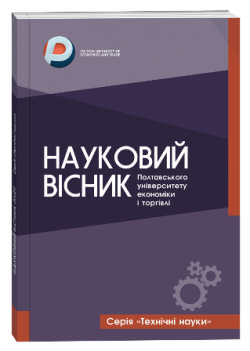CHAENOMELES AS A MULTIFUNCTIONAL ADDITIVE IN FOOD PRODUCTION TECHNOLOGY
Abstract
The article is devoted to studying the quality indicators of chaenomeles fruits and their processing products (juice, puree) to justify the multifunctionality of the additives in the food production technology. The prospects and effectiveness of the use of chaenomeles processing products (juice, puree, extract) as natural ingredients, which are characterized by potentially high physicochemical properties due to the unique biochemical composition of chaenomeles fruits, in food technology, are analyzed, which confirms the relevance and perspective of these studies for scientists and their practical application at processing enterprises of the industry and in restaurants. The article's purpose is to justify the possibility of using homeless processing products as a multifunctional additive in the technologies of marinades, seafood, meat semi-finished products, flour, and confectionery products. It has been confirmed that the products of chaenomeles processing (juice, puree) contain a high content of phenolic substances, organic acids, pectin, L-ascorbic acid, and carotene. It was established that the high content of organic acids, particularly malic acids, in the composition of chaenomeles and its processing products, makes it possible to use them as a natural acidity regulator in food recipes. Studies have proven the effectiveness of using chaenomeles juice in marinades, seafood, meat semi-finished products, and during the pre-treatment of raw materials (mushrooms, Jerusalem artichokes, bananas), where the complex of its enzyme system is active, to prevent darkening of raw materials during processing. The possibility of using chaenomeles processing products in the technology of confectionery products with gel-forming properties (panna cotta, mousse), in the technology of flour products to increase the biological value of products and extend the shelf life of products, and prevent aging processes has been proven. Using the fruits of chaenomeles processing in food production technology positively affects their organoleptic, structural, and mechanical indicators and increases their biological value.
References
2. Safety evaluation of certain food additives and contaminants. Joint FAO/WHO Expert Committee on Food Additives (JECFA). Geneva. 2011. P. 544.
3. Lykholat, Y. V., Khromykh, N. O., Lykholat, T. Y., Didur, O. O., Lykholat, O. A., Legostaeva, T. V., & Grygoryuk, I. P. Industrial characteristics and consumer properties of Chaenomeles Lindl. fruits. Ukrainian Journal of Ecology. 2019. Vol. 9(3). P. 132-137.
4. Хомич, Г. П., Ткач, Н. І., & Левченко, Ю. В. Дослідження хімічного складу плодів хеномелесу і використання його в соковому виробництві. Вісник Донецького національного університету економіки і торгівлі ім. Михайла Туган-Барановського. 2014. Сер.Технічні науки, (1), C. 98-104.
5. Watychowicz K, Janda K, Jakubczyk K, Wolska J. Chaenomeles – health promoting benefits. Rocz Panstw Zakl Hig. 2017. Vol.68(3)/ P. 217-227.
6. Itoh S, Yamaguchi M, Shigeyama K, Sakaguchi I. The Anti-Aging Potential of Extracts from Chaenomeles sinensis. Cosmetics. 2019 Vol. 6(1) P. 21.
7. Ieva Urbanaviciute, Mindaugas Liaudanskas, Dalija Seglina & Pranas Viskelis. Japanese Quince Chaenomeles Japonica (Thunb.) Lindl. ex Spach Leaves a New Source of Antioxidants for Food. International Journal of Food Properties, 2019. Vol. 22:1. P. 795-803.
8. Sawai-Kuroda R. A polyphenol-rich extract from Chaenomeles sinensis (Chinese quince) inhibits influenza A virus infection by preventing primary transcription in vitro. Journal of Ethnopharmacology. 2013. Vol № 146. P. 866–872.
9. Osaili T.M. Effect of Essential Oils and Vacuum Packaging on Spoilage-Causing Microorganisms of Marinated Camel Meat during Storage. Food-Borne Disease Prevention and Risk Assessment 2.0 Edition. Foods. 2021.Vol/ 10(12). P. 2980.
10. Osaili, T.M., Hasan F., Dhanasekaran D.K., Obaid R.S., Al-Nabulsi A.A., Ayyash M., Karam L., Savvaidis I.N., Holley, R.M., Osaili T.M. et al. Effect of active essential oils added to chicken tawook on the behaviour of Listeria monocytogenes, Salmonella spp. and Escherichia coli O157:H7 during storage. Int J Food Microbiol. 2021. Vol. 16. P. 337.
11. Khomych G., Horobetc A., Levchenko Y., Boroday A., Ishchenko N. The study of main physical-chemical parameters of chaenomeles and products of its processing. Eureka: Life Sciences. 2016. Vol. 3 (3). P. 50–56.
12. Хомич Г.П., Бородай А.Б., Горобець О.М. Дослідження якісних показників борошняних вирбів з хеномелесом в процесі зберігання. Науковий вісник Львівського Національного університету ветеринарної медицини та біотехнологій ім. С. З. Гжицького. Львів : ЛНАВМ, 2015. Т. 18. № 1 (65). С. 143–148.
13. Хомич Г.П., Горобець О.М. Використання хеномелесу та продуктів його переробки в технології борошняних виробів. Науковий вісник Львівського Національного університету ветеринарної медицини та біотехнологій ім. С. З. Гжицького. Львів : ЛНАВМ, 2015. Т. 17. № 4 (64). С. 174–179.


